Comparison of broccoli and cauliflower
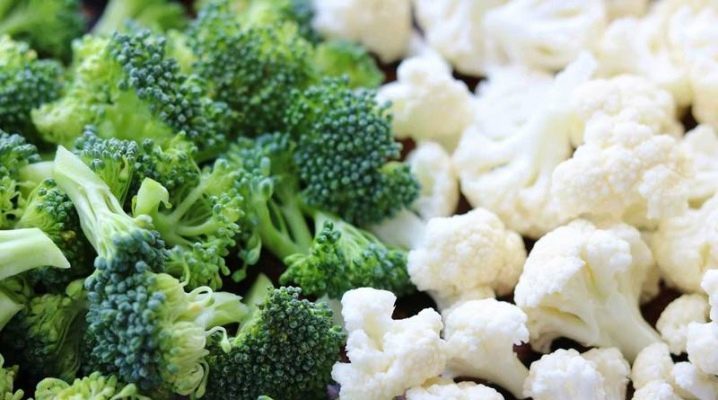
Today it is difficult to imagine that some time ago the white cabbage was the only variety of cabbage in the gardens. Now gardeners of all levels are trying to grow several types of cabbage, among which cauliflower and broccoli are very popular. These varieties are not only not inferior, but in many respects are superior to traditional cabbage. First of all, they win in terms of composition, amount of nutrients, vitamins. Broccoli and cauliflower belong to the same category, but they have a lot of differences, both visually and in quality.
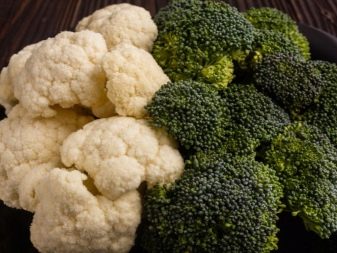
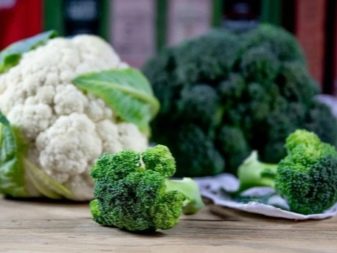
Visual differences
Vegetables such as broccoli and cauliflower are frequent guests in our country's garden plots. First of all, you should define their main qualities.
Cauliflower:
- annual, has fibrous roots located close to the soil surface;
- there is a rounded stem, the height of which varies from 15 to 72 cm, depending on the variety;
- leaves grow up: in a straight or oblique line;
- rosettes are created in the foliage at the top;
- the shape of the fruit is either round or flat-round;
- color varies from white to creamy yellow, but there are varieties of greenish, purple tones (most often white and cream cabbage).
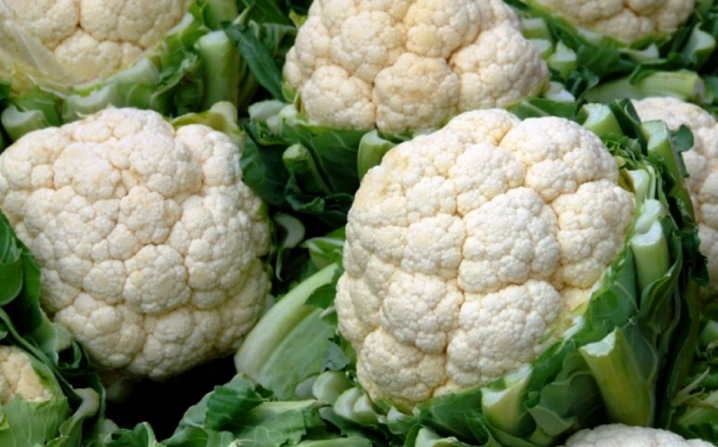
Broccoli:
- became widespread in our country much later than cauliflower, mainly actively grown in Italy;
- stem height varies from 60 to 90 cm;
- inflorescences with green buds are formed at the top;
- the buds gather in large peduncles and form a loose-type fruit;
- the color of the fruit is green.
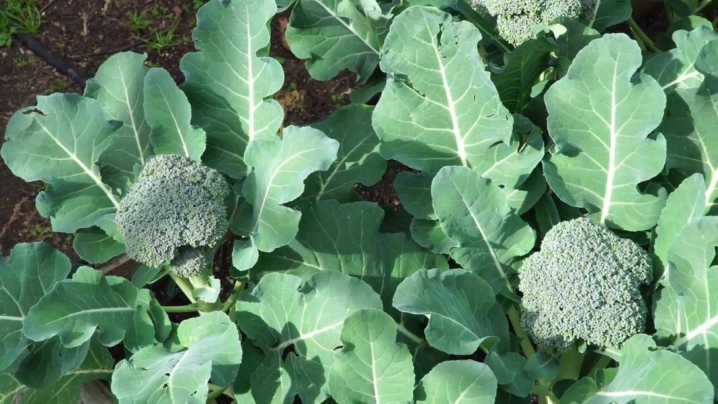
Despite the fact that the fruits of both types look similar, they still differ:
- the height of the stem is different: in broccoli it is much longer;
- cauliflower is most often light: white, yellow, greenish, sometimes purple, broccoli is exceptionally green;
- broccoli inflorescences are larger.
To distinguish the seedlings of two plants, experienced gardeners recommend paying attention to the following nuances:
- leaf shape: in broccoli it is more curly, in color it is similar to white cabbage;
- colored foliage is smaller, rounder;
- broccoli leaf coarser, deep blades;
- petioles differ: in colored ones they are much shorter.
Apart from the external differences, there are obvious differences in composition, nutrient amounts, taste, growing conditions and ripening times.
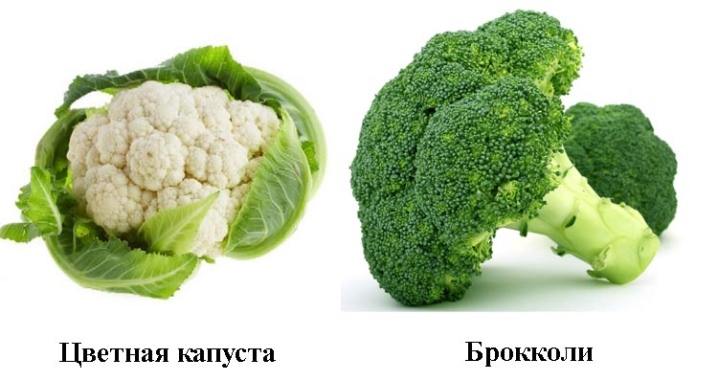
Difference in composition
There are a lot of useful elements in the inflorescences of both vegetables. These vegetables do not need to be cooked for a long time in order to preserve them to the maximum. Cauliflower is great for eating raw. As for the composition, for cauliflower it is as follows (the calculation is per 100 grams):
- more than 90% of the vegetable consists of water;
- protein is present in an amount of 2.5 g;
- fats - 0.3 g, among them there are polyunsaturated Omega fats;
- carbohydrates - about 6.3 g, including fiber, pectin and sugar;
- calorie content - about 30 kcal.
As for vitamins, macro- and microelements, there is a lot of potassium and calcium in cabbage. They are at the top of the list. Also in the composition there is a sufficient amount:
- vitamin C;
- vitamins of group B, E, K;
- biotin;
- folic and pantothenic acid;
- bromine;
- silicon;
- molybdenum;
- bioflavonoids.
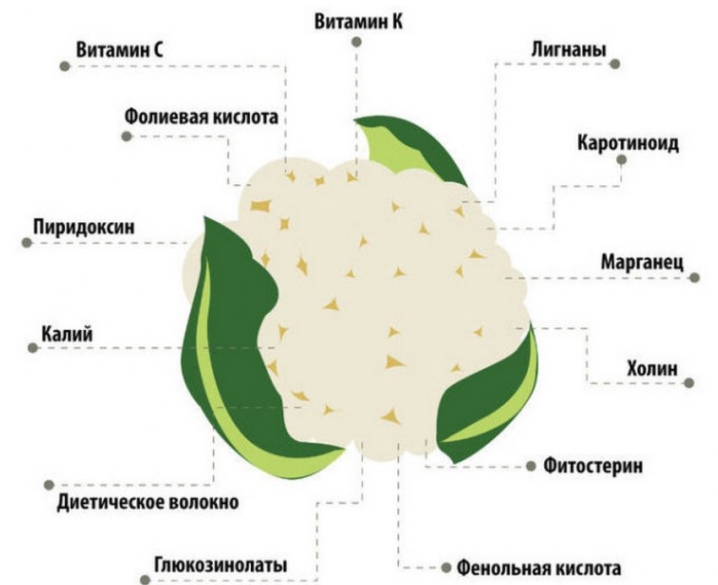
The composition of broccoli is no poorer than its brother in the family, the structure and constituent elements are very diverse:
- slightly less water in the vegetable - 89%;
- a little more calories - 34 kcal;
- more protein - 2.8 g;
- carbohydrates - 6.64 g, but among them there is more fiber, not sugar;
- fat - 0.6 g, also slightly more than in cauliflower.
As can be seen from the presented indicators, fiber and pectin are richer than broccoli, moreover, in this category it is at the "top of Olympus" among all kinds of cabbage. The composition of the mineral and vitamin type is luxurious. Only 100 g of the product fully meet the need for vitamin C, for vitamin K - more than 80%. Also, the vegetable is rich in the following elements:
- organic acids;
- phytosterols;
- carotenoids;
- lutein;
- zeaxanthin;
- vitamins of group B, E, A;
- phosphorus;
- iodine;
- sulfur;
- potassium;
- silicon;
- boron
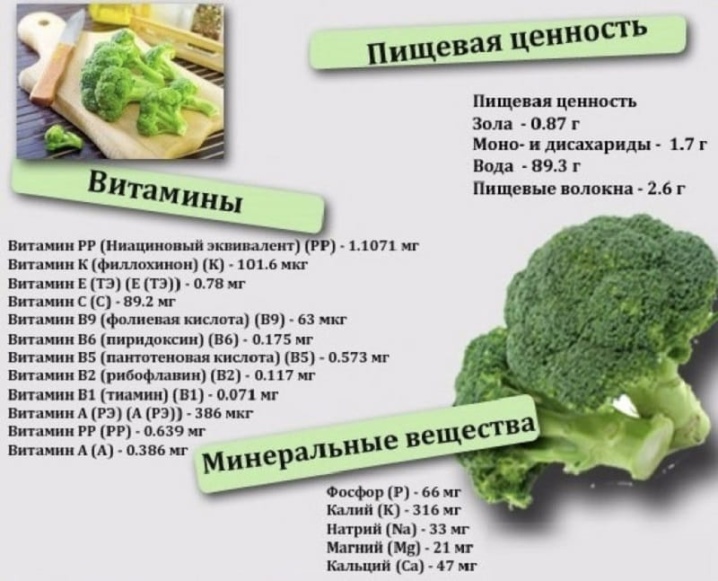
The benefits of both vegetables for the human body are undeniable. They allow you to regulate glucose levels, therefore, are indicated for diabetics. The richest composition of the product does not affect its calorie content at all: it is extremely low in both vegetables.
Growing conditions
Differences in the growing conditions of these vegetables are also obvious. First of all, cauliflower is much more demanding, it needs more maintenance:
- she does not like temperature extremes, droughts, frosts;
- grows best at temperatures between 15 and 20 degrees;
- requires a well-lit area, grows poorly in the shade.
But most of all, cauliflower is capricious in matters of soil composition:
- loves wet, but not waterlogged soil;
- the earth needs a sufficient amount of boron, copper, magnesium, so top dressing is required.

It is possible to grow cauliflower on poor soil composition and in adverse conditions, but this requires more agronomic procedures. Broccoli, on the other hand, is less capricious, especially in terms of soil composition. It is enough to periodically feed it for the plant to actively develop. As for the ideal temperature conditions, they vary between 16-26 degrees.
But there are also features of agricultural technology: broccoli needs abundant moisture. Another difference is that after cutting the fruit of this variety, the stem will continue to bear fruit, forming shoots on the sides.
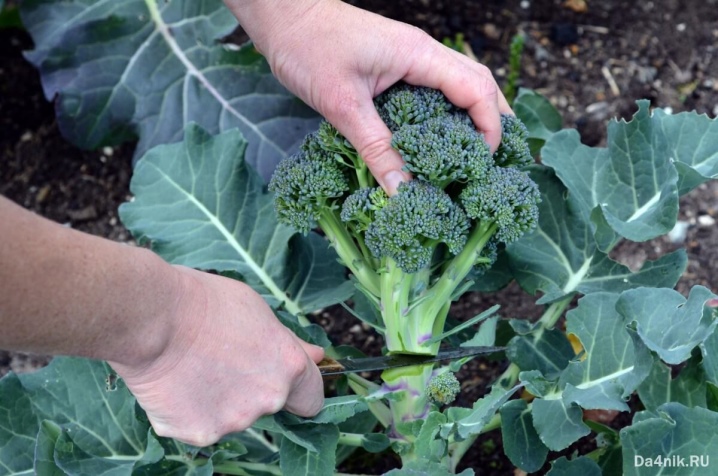
Ripening period
Ripe cauliflower looks like this:
- painted in a color corresponding to the variety;
- has a weight of 0.5 kg.
As for the timing, they depend on the varietal affiliation of the vegetable grown on the site.
- A head of cabbage of early maturing varieties is ready for cutting in 2-3 months after planting. You can harvest at the end of the first summer month or the beginning of the second.
- Mid-season representatives are ready for cutting either at the end of July or in the first decade of August. They need more time to reach maturity. From about 100 days.
- There are also late-ripening types of cauliflower, but they are suitable for cultivation only in the southern regions. The minimum period for which such varieties ripen is 150 days. But this cabbage is well kept. Late cabbage must be harvested before the temperature drops below +10 degrees.
In order for the vegetable to ripen on time, it is necessary to provide a rich soil composition, a comfortable temperature regime, competent watering and plenty of sunlight. Depending on the listed conditions, the ripening time can vary, and significantly.
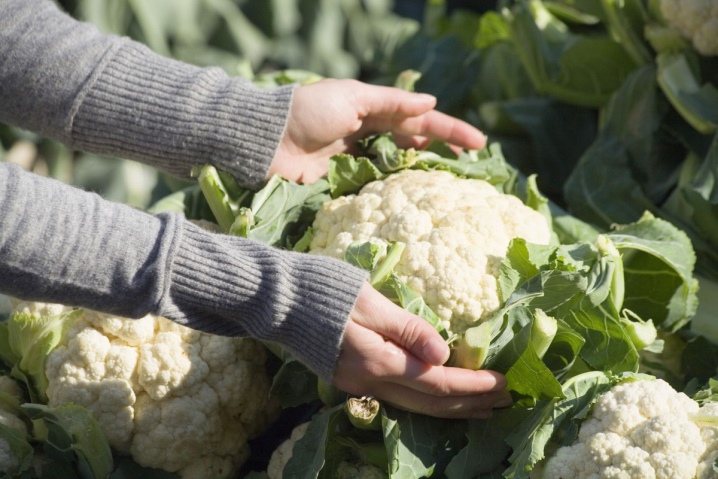
As for broccoli, everything is different here: there are no clear ripening periods, they are quite labile. Much depends on climatic conditions, seasonal weather, agricultural procedures. However, there are approximate dates, which are usually indicated on the seed bag. They range from 2 months to 85 days. However, early varieties are distinguished, which are ready for cutting 2 months after planting, as well as late-ripening species, which require 75 to 85 days.
To speed up ripening, it is better not to plant the plant in open ground, but to prepare seedlings. You can determine the level of maturity of a vegetable by the following criteria:
- the diameter of the head is more than 10 cm;
- weight exceeds 250 g;
- the fruit has a dense structure and a juicy greenish tint.
The head of cabbage should not be allowed to turn yellowish. This suggests that the moment of ripening is missed and the fruit is overripe. It is better to refuse to use this specimen as food, since it has lost its taste and useful qualities. In this case, the head of cabbage is cut off, and the stem remains in place, since after cutting the upper fruit, lateral ones begin to form.

If you want to delay the maturation period, you need to prevent the heads of cabbage from blooming. To do this, they are covered with foliage and fastened with an elastic band at the top. After the gum is removed, the fruit will be ready for cutting in a couple of days. Broccoli is harvested before the onset of frost, since the vegetable does not at all tolerate temperature fluctuations in minus.
What is the best choice?
Both vegetables are good enough for your health and are good for a healthy diet.... Therefore, you can choose between them according to a simple principle: which is tastier for you. If you like both vegetables equally, but there is no place on the site, you should evaluate the growing conditions and choose the appropriate option. In addition, it is important to assess the benefits for certain aspects of health. This is perhaps the most important category for evaluating vegetables.
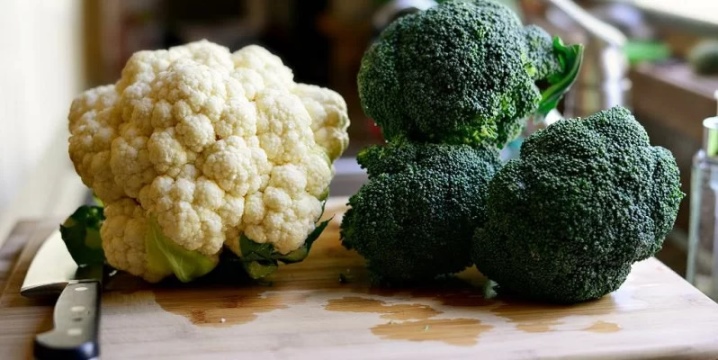
So, in terms of composition, cauliflower can be useful:
- as a dietary product for those who are overweight, diabetics;
- with hepatic ailments, gallstone problem;
- suffering from atherosclerosis.
This vegetable has a healthy effect on the human body:
- improves digestion and normalizes salt-water balance;
- makes bones and joints stronger, serves as the prevention of various arthritis and osteoporosis;
- helps to produce hormones correctly, improves the state of the system as a whole;
- strengthens the nerves, relieves depressive conditions, insomnia;
- improves the condition of the heart and blood vessels;
- does not allow sand and stones to be deposited in any organs;
- helps to keep sugar and cholesterol under control, strengthens blood vessels;
- acts as an antioxidant, has anti-inflammatory effect;
- prevents cancer.
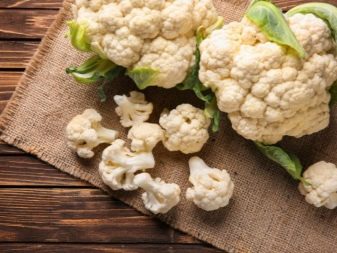

With all the useful qualities, this vegetable should be limited in the diet to certain categories:
- gout;
- suffering from hyperfunction of the thyroid gland;
- people with kidney disease;
- hypertensive patients;
- in the postoperative period, when interventions were performed in the abdominal cavity;
- persons with individual intolerance and allergy sufferers.
The composition of broccoli is not inferior in value. If you include cabbage in your diet on an ongoing basis, you can help the body cope with various problems:
- it is a powerful antioxidant that has anti-cancer effects;
- excellent choleretic;
- digestive system assistant;
- prevents gastritis, ulcers, colitis, enteritis;
- suitable for normalizing glucose, cholesterol levels;
- perfectly cleanses the body of toxins and salts;
- relieves dental ailments;
- improves eye health;
- helps with mastopathy;
- suitable for obesity nutrition.
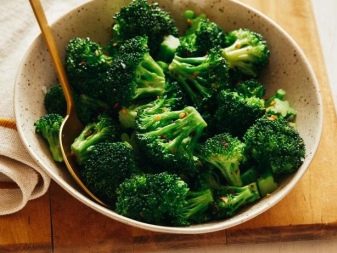

Compared to cauliflower, broccoli definitely benefits from antioxidant benefits. Due to its unique composition, the vegetable is able to slow down the growth of already existing malignant formations. It contains indoles, vitamin C, which destroy tumors. This vegetable is indispensable in the nutrition of women of mature age, in whom the level of estrogen decreases. In addition to female oncology, the benefits of broccoli in bowel, prostate, and urological cancers have been proven.
But there are people who should be wary of including broccoli in their diet. It:
- persons with a high level of stomach acidity;
- people who have problems with blood clots: thrombosis, thrombophlebitis, too thick blood;
- suffering from allergies and individual intolerance to the product.
You should weigh the pros and cons before deciding which vegetable to include in your diet on a regular basis.
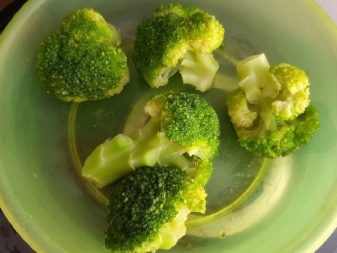














The comment was sent successfully.